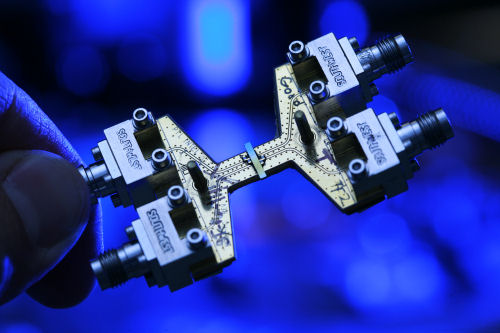Intel Speed Breakthrough Points to a Post-Motherboard Era
Up to now, when photonics have been used in silicon-based alternatives to electrical semiconductors, loose electrons altering the refractive index of the silicon have prevented high speeds. Now Intel engineers claim they've found a way around the problem, perhaps eliminating a principal obstacle to the development of optical interconnects at hundreds of gigabits per second and beyond.
The typical reason engineers like to design devices with as many components as possible on a single board seems obvious: Separate the components into separate parts, and you'd need to engineer some way for the parts to communicate with one another. Technically speaking, intra-system networking has been a feasibility for several years, but the latencies it would introduce are certainly measurable.
As the current development path for supercomputers indicates, parallelism is the key to achieving once unthinkable throughputs of one terabit per second or more. Cramming thousands of chips onto a single board is a difficult task unless you think in three dimensions - and recently, Intel has certainly experimented in that direction in conceptualizing "stackable" multicore processors, for better or worse.
But two weeks ago at a photonics conference in Salt Lake City, Intel invited a select group of scientists to witness and verify its latest achievement in materials science: a silicon-based optical modulator that enables throughput at 40 Gbps, which is 10 Gbps faster than a test chip produced just last January.
While such a speed has been attained before, it's required unusual and exotic III-V semiconductor compounds. The refractive index of silicon typically makes such throughputs impossible, as light throughput usually exhibits what's referred to as a "roll-off" after certain speeds.
Last September, BetaNews reported how Intel had developed a single-chip-based laser for use in photonics processing. For that, it resorted to using indium phosphide for producing a light source. That's for producing light; for modulating it, up to this point, Intel and others have resorted to lithium niobate -- a material also critical to superconductor research -- mainly because crystalline silicon doesn't behave the way a typical modulator should. Back then, Intel said it could resort to using silicon if it could perfect the process of compensating for how the material's refractive index varies at higher throughput speeds.
This is exactly what Intel's photonics team is accomplishing. Similar to the way an electrical semiconductor works, a silicon photonic modulator splits light into two waves - a process called birefringence.
When negative voltage is applied to the junctions along which those split waves travel, the extra electrons that travel the junction and that clog up the refraction process at high speeds, called "free carriers," are flushed out. When the split waves are recombined prior to demodulating back to an electrical form, the compound form either assumes a simple, square waveform (1) or no signal (0), without the introduction of radical elements that cloud and even destroy the signal. By shifting the transmitted signal in and out of phase, it can then be used to represent data, so that the recombined, received signal becomes truer to the original.

This phase shift process, according to Intel researcher Ansheng Liu, enables practically ordinary crystalline silicon to form the basis of a modulator that transmits at 30 GHz rates, and that modulates data at a rate of 40 Gbps.
One of Intel's goals is to create an optical interconnect between processor component boards that are much smaller than today's, and that enable chips to work in parallel as though they were soldered onto the same substrate to begin with. Think of a processor module that you could enhance simply by snapping another module to the side, like building a supercomputer out of Legos.
As Intel CTO Justin Rattner wrote yesterday, "Achieving 40 Gbps using a silicon laser modulator is a significant milestone for silicon photonics in that we've matched the data transmission speed records set by the fastest III-V optical devices available today. We see silicon photonics at the heart of future, low cost optical interconnects for tera-scale computing."